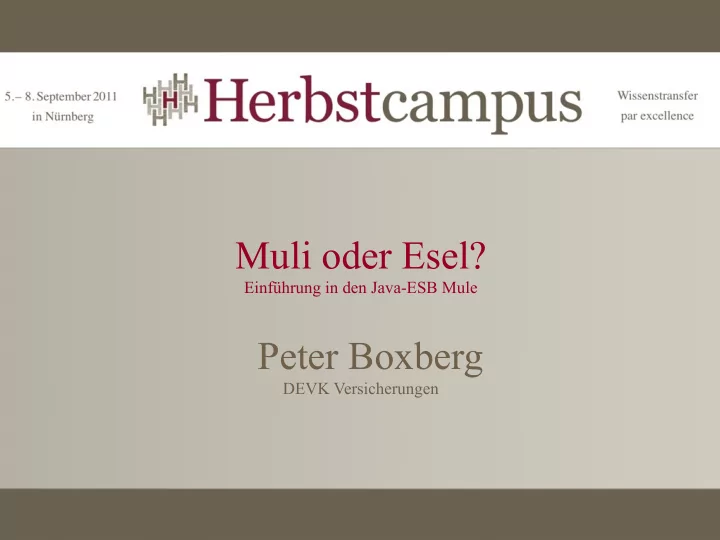

Muli oder Esel? Einführung in den Java-ESB Mule Peter Boxberg DEVK Versicherungen
Mule and Web Services Dan Diephouse, MuleSource
About Me Open Source: Mule, CXF/XFire, Abdera, Apache-* Exploring how to make building distributed services more powerful/approachable/scalable/etc MuleSource http://mulesource.com
Agenda Mule Overview Mule & web services Building web services integration The future
Overview
SOA Swiss Army Knife Supports a variety of service topologies including ESB Highly Scalable; using SEDA event model Asynchronous, Synchronous and Request/Response Messaging J2EE Support: JBI, JMS, EJB, JCA, JTA, Servlet Powerful event routing capabilities (based on EIP book) Breadth of connectivity; 60+ technologies Transparent Distribution Transactions; Local and Distributed (XA) Fault tolerance; Exception management Secure; Authentication/Authorization
Why do developers choose Mule? No prescribed message format XML, CSV, Binary, Streams, Record, Java Objects Mix and match Zero code intrusion Mule does not impose an API on service objects Objects are fully portable Existing objects can be managed POJOs, IoC Objects, EJB Session Beans, Remote Objects REST / Web Services Easy to test Mule can be run easily from a JUnit test case Framework provides a Test compatibility kit Scales down as well as up
Mule Node Architecture
Mule Topologies Mule can be configured to implement any topology: Peer Network Enterprise Service Bus Enterprise Service Network Client/Server and Hub n' Spoke Pipeline
Core Concepts: UMO Service UMO Services in Mule can be any object - POJOs, EJBs, Remote Objects, WS/REST Services A service will perform a business function and may rely on other sources to obtain additional information Configured in Xml, or programmatically Mule Manages Threading, Pooling and resource management Managed via JMX at runtime
Core Concepts: Endpoints Used to connect components and external systems together Endpoints use a URI for Addressing Can have transformer, transaction, filter, security and meta-information associated Two types of URI scheme://[username][:password]@[host] [:port]?[params] smtp://ross:pass@localhost:25 scheme://[address]?[params] jms://my.queue?persistent=true
Core Concepts: Routers Control how events are sent and received Can model all routing patterns defined in the EIP Book Inbound Routers Idempotency Selective Consumers Re-sequencing Message aggregation Outbound Routers Message splitting / Chunking Content-based Routing Broadcasting Rules-based routing Load Balancing
Core Concepts: Transformers Transformers Converts data from one format to another Can be chained together to form transformation pipelines <jms:object-to-jms name="XmlToJms"/> <custom-transformer name="CobolXmlToBusXml" class="com.myco.trans.CobolXmlToBusXml"/> <endpoint address="jms://trades" transformers="CobolXmlToBusXml, XmlToJms"/>
Mule and Web Services
Our scenario Bookstore Book list Client Bookstore (CSV) Service Publisher + addBooks + getBooks Bookstore Client Email order confirmation Bookstore Buyer
How? Mule provides File connector Email connector CXF connector What’s CXF? Successor to XFire Apache web services framework JAX-WS compliant SOAP, WSDL, WS-I Basic Profile WS-Addressing, WS-Security, WS-Policy, WS- ReliableMessaging
How? Build web service 1. Configure Mule server 2. Generate web service client 3. Build CSV->Book converter 4. Configure Mule with File inbound router and CXF 5. outbound router Configure Mule with Email endpoint to confirm 6. orders Send messages to email service from bookstore 7.
Quick Intro to JAX-WS The standard way to build SOAP web services Supports code first web service building through annotations Supports WSDL first through ant/maven/command line tools
Building the Web Service public interface Bookstore { long addBook(Book book); Collection<Long> addBooks(Collection<Book> books); Collection<Book> getBooks(); }
Annotating the service @WebService public interface Bookstore { long addBook(@WebParam(name="book") Book book); @WebResult(name="bookIds") Collection<Long> addBooks( @WebParam(name="books") Collection<Book> books); @WebResult(name="books") Collection<Book> getBooks(); void placeOrder(@WebParam(name=“bookId”) long bookId, @WebParam(name=“address”)String address, @WebParam(name=“email”)String email) }
Data Transfer Objects public class Book { get/setId get/setTitle get/setAuthor }
Implementation @WebService(serviceName="BookstoreService", portName="BookstorePort“, endpointInterface="org.mule.example.bookstore.Bookstore" ) public class BookstoreImpl implements Bookstore { … }
Configuring Mule <mule-descriptor name="echoService" implementation="org.mule.example.bookstore.BookstoreImpl "> <inbound-router> <endpoint address="cxf:http://localhost:8080/services/bookstore"/> </inbound-router> </mule-descriptor>
Starting Mule Web applications Embedded Spring Anywhere!
Main.main() – simplicity MuleXmlConfigurationBuilder builder = new MuleXmlConfigurationBuilder(); UMOManager manager = builder.configure("bookstore.xml");
What happened?
Some notes about web services Be careful about your contracts!!! Don’t couple your web service too tightly (like this example), allow a degree of separation This allows Maitainability Evolvability Versioning WSDL first helps this
The Publisher Wants to read in CSV and publish to web service Use a CXF generated client as the “outbound router” CsvBookPublisher converts File to List<Book> Books then get sent to outbound router
Our implementation public class CsvBookPublisher { public Collection<Book> publish(File file) throws IOException { … } }
Domain objects are the Messages File Book Title Author Access can be gained to raw UMOMessage as well
Generating a client <plugin> <groupId>org.apache.cxf</groupId> <artifactId>cxf-codegen-plugin</artifactId> <version>2.0.2-incubator</version> <executions> <execution> <id>generate-sources</id> <phase>generate-sources</phase> <configuration> <sourceRoot> ${basedir}/target/generated/src/main/java </sourceRoot> <wsdlOptions> <wsdlOption> <wsdl> http://localhost:8080/services/bookstore?wsdl </wsdl> </wsdlOption> </wsdlOptions> </configuration> <goals> <goal>wsdl2java</goal> </goals> </execution> </executions> </plugin>
Our configuration <mule-descriptor name="csvPublisher" implementation="org.mule.example.bookstore.publisher.CsvBookPublisher" singleton="true"> <inbound-router> <endpoint address="file://./books? pollingFrequency=100000&autoDelete=false"/> </inbound-router> <outbound-router> <router className="org.mule.routing.outbound.OutboundPassThroughRouter"> … </router> </outbound-router> </mule-descriptor>
Outbound router configuration <router className="org.mule.routing.outbound.OutboundPassThroughRouter"> <endpoint address="cxf:http://localhost:8080/services/bookstore"> <properties> <property name="clientClass" value="org.mule.example.bookstore.BookstoreService"/> <property name="wsdlLocation" value="http://localhost:8080/services/bookstore?wsdl"/> <property name="port" value="BookstorePort"/> <property name="operation" value="addBooks"/> </properties> </endpoint> </router>
Start it up!
Email Integration Order (Book, Order to email Email, transformer Address) Place Object to Message Bookstore Order transformer SMTP endpoint
Endpoint Configuration <global-endpoints> <endpoint name="orderEmailService" address="smtps://username:password@hostname" transformers="OrderToEmail ObjectToMimeMessage"> <properties> <property name="fromAddress" value="bookstore@mulesource.com" /> <property name="subject“ value="Your order has been placed!" /> </properties> </endpoint> </global-endpoints>
Transformers <transformers> <transformer name="OrderToEmail" className="org.mule.example.bookstore.OrderToEmailTransformer"/> <transformer name="ObjectToMimeMessage" className="org.mule.providers.email.transformers.ObjectToMimeMessage"/> </transformers>
Recommend
More recommend